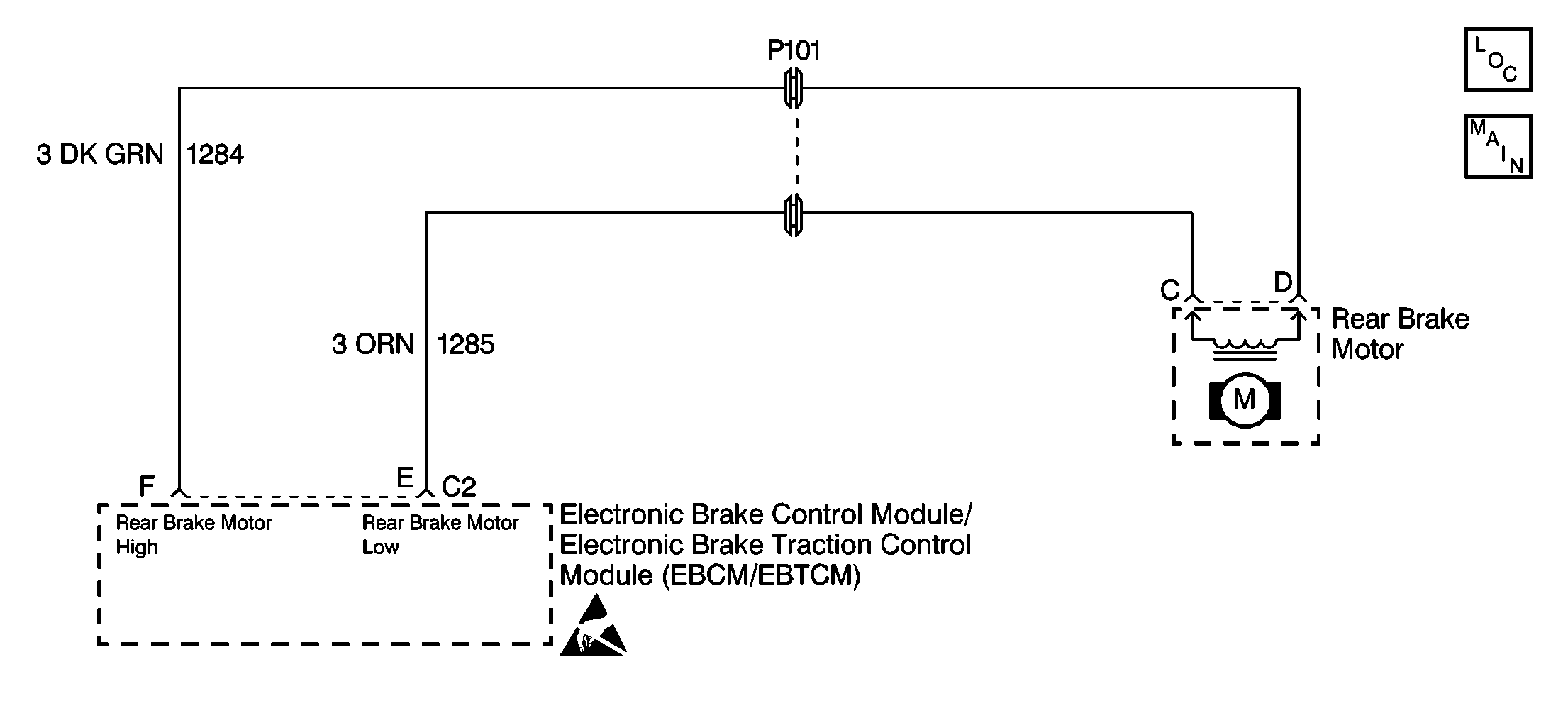
Circuit Description
DTC C1246 detects a bound-up ESB, a stuck ABS motor, or a seized brake modulator. When the release is commanded during initialization, the ESB should release the ABS motor, resulting in the sensed current being less than the commanded current (motor spins freely). If the ABS motor is not moving the sensed current will be equal to stall currents.
Conditions for Setting the DTC
DTC C1246 can set during an ABS stop or during a brake motor initialization at the following speeds:
| • | 0 km (0 mph) when the brake is off |
| • | 5 km (3 mph) when the brake is on |
A malfunction exists if the EBCM/EBTCM detects a condition in which the EBCM/EBTCM cannot move the ABS motor in either direction.
Action Taken When the DTC Sets
| • | A malfunction DTC stores. |
| • | The ABS/TCS disables. |
| • | The amber ABS/TCS warning indicators turn on. |
Conditions for Clearing the DTC
| • | The condition responsible for setting the DTC no longer exists and the Scan Tool Clear DTC function is used. |
| • | 100 drive cycles pass with no DTC detected. |
Diagnostic Aids
The following conditions may cause an intermittent malfunction if the conditions exist in a mechanical part of the system:
| • | Sticking |
| • | Binding |
Use the enhanced diagnostic function of the Scan Tool in order to measure the frequency of the malfunction. Refer to the Scan Tool manual or Scan Tool Diagnostics located in this section for the procedure. DTC C1246 may set after modulator disassembly, if the modulator pistons are positioned at the bottom of the modulator piston bore. Depending on the frequency of the malfunction, a physical inspection of the mechanical parts suspected of causing the malfunction may be necessary.
Thoroughly inspect any circuitry that may be causing the intermittent complaint for the following conditions:
| • | Backed out terminals |
| • | Improper mating |
| • | Broken locks |
| • | Improperly formed or damaged terminals |
| • | Poor terminal-to-wiring connections |
| • | Physical damage to the wiring harness |
Clear the DTCs after completing the diagnosis. Test drive the vehicle for three drive cycles in order to verify that the DTC does not reset. Use the following procedure in order to complete one drive cycle:
- Start the vehicle.
- Drive the vehicle over 16 km/h (10 mph).
- Stop the vehicle.
- Turn the ignition to the OFF position.
Important: Zero the J 39200 test leads before making any resistance measurements.
Step | Action | Value(s) | Yes | No | ||||||||
|---|---|---|---|---|---|---|---|---|---|---|---|---|
1 | Was the Diagnostic System Check performed? | -- | Go to Step 2 | Go to Diagnostic System Check | ||||||||
2 | Inspect the following connectors for the correct wire color/connector cavity combinations:
Are the correct wires located in the correct connector cavities? | -- | Go to Step 3 | Go to Step 11 | ||||||||
3 |
Is it possible to rotate the rear wheels by hand? | -- | Go to Step 5 | Go to Step 4 | ||||||||
4 |
Is it possible to rotate the rear wheels by hand? | -- | Go to Step 17 | Go to Step 5 | ||||||||
5 |
Carefully observe the following currents:
Is the rear axle motor feedback current less than or equal to the specified current? | 8 A | Go to Step 6 | Go to Step 10 | ||||||||
6 |
Is the resistance within the specified range? | OL (Infinite) | Go to Step 7 | Go to Step 12 | ||||||||
7 | Use the J 39200 in order to measure the resistance between the ABS brake motor pack connector terminal C and the ABS brake motor pack connector terminal D. Is the resistance within the specified range? | 0.2-1.5 ohms | Go to Step 8 | Go to Step 13 | ||||||||
8 |
Do any of the terminals exhibit poor terminal contact or corrosion? | -- | Go to Step 15 | Go to Step 9 | ||||||||
9 |
Does DTC C1246 set during the last three ignition cycles? | -- | Go to Step 16 | Go to Step 17 | ||||||||
10 |
Is it possible to rotate the middle gear on the hydraulic modulator from lock to lock, 5 to 9 revolutions? | -- | Go to Step 13 | Go to Step 14 | ||||||||
11 | Place the wires into the correct connector cavities. Is the repair complete? | -- | Go to Diagnostic System Check | -- | ||||||||
12 | Repair the short between CKT 1284 and CKT 1285. Is the repair complete? | -- | Go to Diagnostic System Check | -- | ||||||||
13 | Replace the ABS motor pack. Refer to ABS Motor Pack Replacement . Is the repair complete? | -- | Go to Diagnostic System Check | -- | ||||||||
14 | Replace the ABS brake modulator. Refer to Brake Modulator Replacement Is the repair complete? | -- | Go to Diagnostic System Check | -- | ||||||||
15 | Replace the terminals that exhibit signs of poor terminal contact or corrosion. Is the repair complete? | -- | Go to Diagnostic System Check | -- | ||||||||
16 | Replace the EBCM/EBTCM. Refer to Electronic Brake and Traction Control Module Replacement . Is the repair complete? | -- | Go to Diagnostic System Check | -- | ||||||||
17 | The malfunction is intermittent or not present at this time. Is a concern still present? | -- | Go to Diagnostic Aids | Go to Diagnostic System Check |
